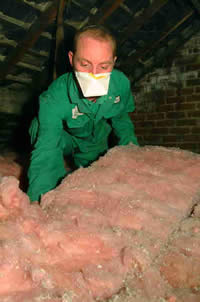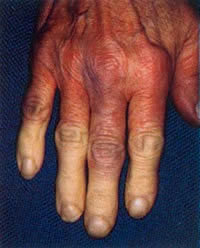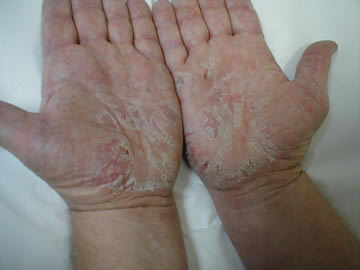
Industrial Disease:
Industrial disease is usually the result of employees being exposed to hazardous substances or work practices over long periods time. Below are some of the most common industrial diseases suffered in the UK:
Hand & Arm / Whole Body Vibration
1: Asbestosis Related Disease
With over 5000 people a year dying as a result of asbestos exposure, this is the single biggest cause of industrial disease in the UK.
What is asbestos?
Asbestos is a number of naturally occurring minerals which form long fibres and fibre bundles. There are three main types of asbestos, white asbestos which has been the most frequently mined, brown asbestos and blue asbestos. All of these have been used extensively in building and insulation throughout the UK.

When Is It Hazardous?
Asbestos is only a problems when the fibres become airborne and are inhaled, so the material needs to be disturbed in some way to release it into the atmosphere.
Asbestos Diseases:
Asbestos inhalation can cause the following illnesses:
Asbestosis:
Usually as a result of prolonged exposure to asbestos, this condition involves scarring of the lungs which causes breathlessness, a dry cough and is sometimes fatal.
This condition can take a number of years to appear, often 10 years or much longer after the initial exposure to asbestos.
Sufferers are entitled to compensation subject to proving liability and causation in other words who is to blame for the exposure and did the exposure cause the condition.
Mesothelioma:
Mesothelioma is a malignant cancer of the lining of the lungs, causing breathlessness and pain.
Sufferers are entitled to compensation subject to proving liability and causation in other words who is to blame for the exposure and did the exposure cause the condition.
Bilateral Defuse Thickening:
This condition restricts the lungs from expanding, creating a shortness of breath. It is widely believed that even a short exposure to asbestos can cause this condition.
This can be attributable in causing lung cancer so if the person is suffering from lung cancer and this condition, a claim for compensation could be considered but again this is subject to liability and causation .
Plaques:
These are areas of thickening of the outer membrane, around the lungs, caused by prolonged asbestos exposure. These plaques can only be detected by x rays and rarely cause problems to the sufferer.
.
Occupations At Risk From Asbestos:
Asbestos was used widely in building construction and ship building up until the 1980s when strict regulations on the control and use of asbestos were brought in. Anyone working in the following occupations particularly before the 1980s could be at risk:
- Metal Plate Workers
- Vehicle Body Builders
- Gas Fitters
- Plumbers
- Carpenters
- Electricians
- Sheet Metal Workers
- Electrical Plant Operators
- Production Fitters
- Construction Workers
- Electrical Engineers
These occupations can be associated with three main industries:
- Shipbuilding
- Railways Carriage and locomotive building.
- Building and Construction, particularly those who install lagging or other insulation materials.
2: Hand & Arm / Whole Body Vibration
Vibration syndrome can affect everything from the fingers tips to the arm and the whole body.

Hand & Arm :
Symptoms:
- Pins and needles / numbness in fingers, arms and wrists.
- Blanching (whiteness) particularly in the finger tips.
- Reduced dexterity causing problems picking things up particularly in cold weather.
- Redness and pain in the hands particularly after going from the cold to the warm.
Occupations Affected:
- Anyone in occupations where vibratory tools are used on a regular basis are at risk e.g.:
- Construction Workers
- Demolition Workers
- Road Maintenance workers (road breakers)
- Shoe Makers
Whole Body Vibration:
This problem is often caused by vibration which is transmitted through a seat or the feet.
Symptoms - The major symptom of whole body vibration is back pain.
Occupations Affected :
- Drivers of vibrating mobile machinery are most at risk, e.g. tractors, fork lifts and earth moving machinery drivers.
3: Occupational Asthma
According to the HSE there have been an estimated 1,500 to 3,000 news cases of occupational asthma each year and this condition is the most frequently reported respiratory disease in Great Britain.

Causes of Occupational Asthma:
Occupational Asthma is caused by exposure to the following substances and the following occupations are at risk:
- Substances: Occupations At Risk
- Isocyanates Spray painters, vehicle repairers, plastic workers etc.
- Flour Bakers
- Grain Farmers
- Glutaraldehyde Nurses, laboratory technicians
- Wood Dust Carpenters
- Latex Electronic assemblers
- Laboratory Animals Scientists and assistants
- Resins and Glues Chemical/metal/electrical processors, construction and mining.
4: Industrial Deafness
Recent research indicates that more than 170,000 people in the UK suffer from ear conditions as a result of exposure to excessive noise at work.
Symptoms:
- Difficulty hearing others speak.
- Noises or ringing in ears.
- Temporary deafness.
Occupations At Risk:
Anyone who works in an occupation where there is industrial noise is at risk, particularly if they have not been issued with adequate ear protection. If you work in an environment where it is difficult to hear someone around 2m away then there could well be excessive levels of noise in your occupation.
5: Occupational Skin Diseases
HSE confirm an estimated average of 7,000 individuals self reported work related skin diseases for 2019/20 -2023/24 according to the Labour Force Survey , making this a fairly prevalent issues in the UK.

Symptoms:
The most common occupational skin disease is contact dermatitis and symptoms tend to start with raw, itchy skin, leading to cracked skin and soreness.
Causes:
The most common cause of skin diseases are rubber chemicals and materials, followed by soaps and cleaners.
Occupations At Risk:
- Florists
- Beauticians
- Hairdressers
- Barbers
- People working in the manufacture of chemicals
- 2
3
 |
||
| "Graham M Riley & Co are authorised and regulated by the Solicitors Regulation Authority and are members of the Law Society of England & Wales and employ members of the Association of Personal Injury Lawyers (APIL), so you can be sure that you will receive the highest standards of service at all times." | ||
